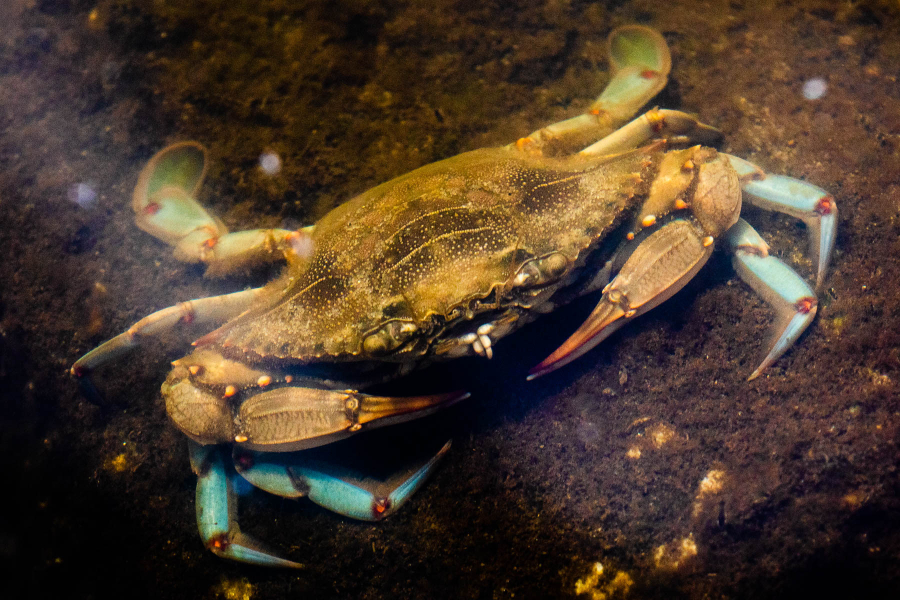Bay scientists evaluate reasons for the blue crab’s population decrease
Invasive fish, disease, warming waters and more are seen as threats to blue crabs

In recent years, the number of blue crabs in the Chesapeake Bay has decreased. This trend has scientists, resource managers, watermen and people who enjoy eating blue crabs concerned—and eager to learn more about the situation.
Blue crab population numbers are naturally highly variable. The population can vary dramatically from year to year for a variety of reasons including environmental factors, predator-prey interactions, habitat limitations and biological conditions.
But last year’s (2021-22) Winter Dredge Survey (where Maryland and Virginia carry out field sampling to track the Bay’s blue crab population) found that the total abundance of blue crabs in the Bay was estimated at 227 million. That is the lowest estimate since the survey began in 1990—and the third consecutive annual decrease.
To better understand the downward trend, scientists on the Chesapeake Bay Stock Assessment Committee (CBSAC) held a workshop in September 2022 to bring together blue crab experts. At the workshop, they discussed the most up-to-date science related to blue crabs and identified information gaps they want to fill to help them better understand blue crab population dynamics. CBSAC recently released a report on the workshop proceedings.
The topics they discussed include:
- Blue crab larvae need high-salinity water as they develop. More frequent and intense storms as a result of climate change could therefore affect blue crab abundance.
- Hypoxia—areas of low dissolved oxygen that occur mostly in the summertime—may affect blue crabs. Crabs need oxygen and in their efforts to get to areas with more oxygen, they may end up facing greater predation and harvest.
- Warmer waters could increase blue crab growth rates. But temperatures over 30 degrees Celsius could drive higher mortality rates.
- Loss of nursery habitats due to climate change, sea level rise and low dissolved oxygen caused by excess nutrients is a serious concern for the blue crab population.
- Blue catfish and red drum are two species of fish that are predators of blue crabs. As waters warm, more red drum may use the Bay as a summer feeding ground, eating more juvenile crabs in the Bay shallows. Blue catfish are an invasive species in the Chesapeake, living and foraging in the tributaries where juvenile blue crabs also live. Increasing numbers of blue catfish could have drastic effects on crab survival in these areas.
- Diseases are a known source of blue crab mortality, but there are many data gaps in this area.
- The Winter Dredge Survey effectiveness may face challenges as fewer crabs are motivated to hunker down in the mud to over winter. When they do this, it allows experts to more easily count the population.
- Shifting current patterns may be affecting how blue crab larvae are transported.
- Sex ratio issues—primarily limitations on the availability of sperm—may be affecting the population.
CBSAC scientists and resource managers also wanted to lay the groundwork for an updated benchmark stock assessment. A stock assessment evaluates the condition of a population and fishery, guiding management of a species. The most recent stock assessment was completed in 2011. Incorporating new information and assumptions into the model that guides blue crab management in the Chesapeake Bay could help resource managers respond more effectively to any challenges the blue crab population faces.
At the workshop, the team developed an initial timeline for the complex process of developing a full stock assessment. The current timeline would have the stock assessment completed in 2025.
In the meantime, scientists and resource managers will continue to monitor the crab population and responsibly manage the commercial and recreational harvest of the Bay’s treasured blue crabs. CBSAC will review upcoming results from the Winter Dredge Survey, last year’s harvest data and other information as it develops the annual Blue Crab Advisory Report, which helps the three jurisdictions that manage blue crabs in the Chesapeake (Maryland, Virginia and the Potomac River Fisheries Commission) make decisions about fishing guidelines.

Comments
There are no comments.
Thank you!
Your comment has been received. Before it can be published, the comment will be reviewed by our team to ensure it adheres with our rules of engagement.
Back to recent stories